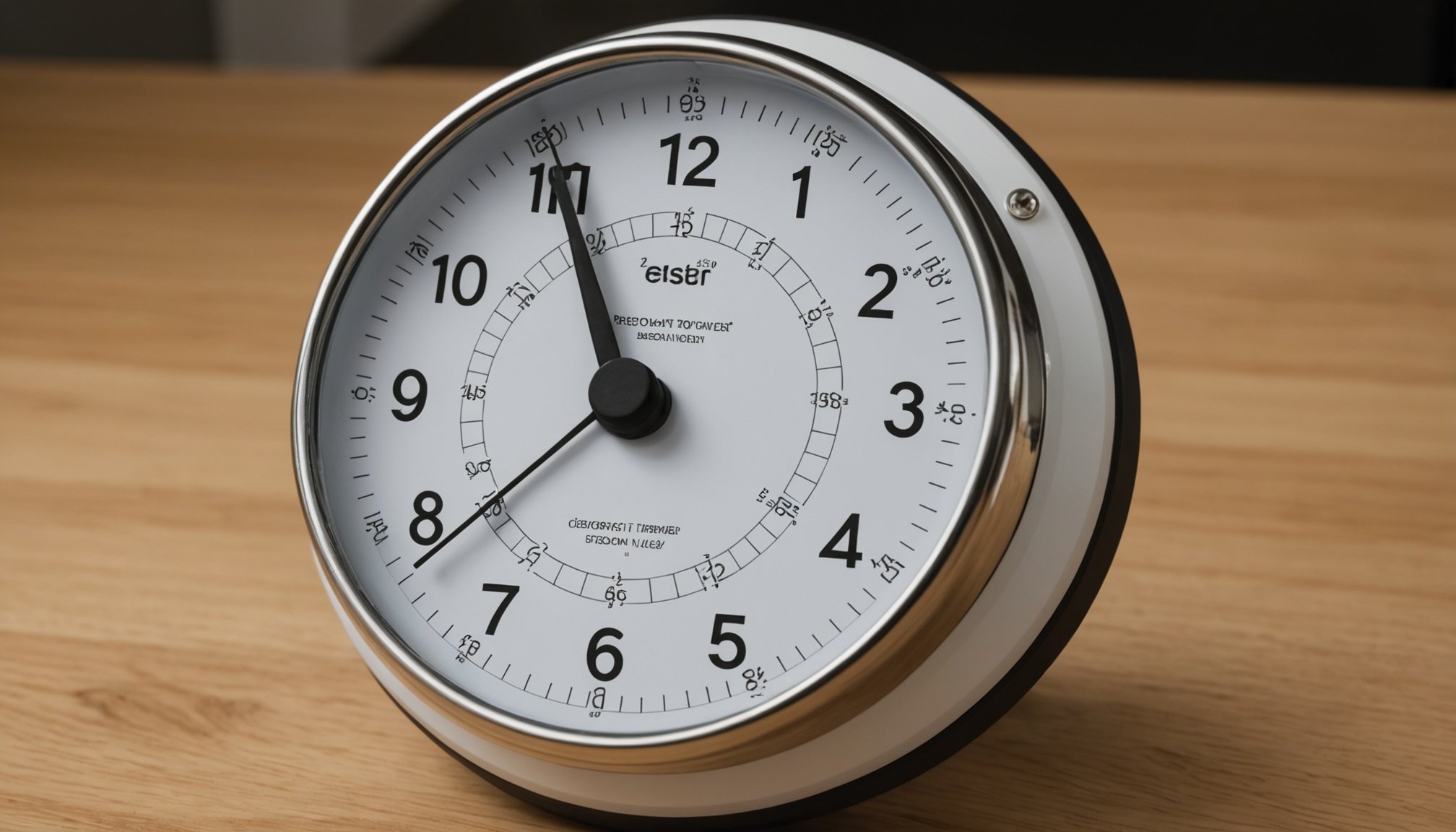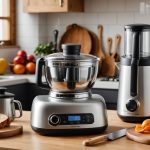Critical Design Features for Visually Accessible Kitchen Timers
Designing visually accessible timers involves incorporating features that accommodate diverse visual abilities, ensuring every user can interact with them effectively.
At the core of inclusive design lies the importance of tactile feedback. This aspect allows users to operate timers through touch, providing an intuitive interaction that doesn’t rely solely on sight. Tactile features like raised markers, braille, or textured surfaces on buttons are common. For instance, a well-known practice in successful implementations is using distinct textures across timer settings. This enables users to differentiate settings without visual references, enhancing accessibility.
In the same genre : The complete handbook for choosing your ideal soda maker: effortlessly carbonate any beverage!
Materials play a crucial role in crafting effective tactile features. Durable and responsive materials such as silicone and soft rubber are recommended as they deliver clear, reliable feedback upon touch. These materials not only ensure the longevity of the tactile components but also provide a pleasant feel under the fingers, vital for those relying on touch as their primary interaction method. The choice of material can significantly impact the usability and effectiveness of the tactile cues.
By putting emphasis on tactile feedback as part of the inclusive design, accessible kitchen timers can better serve users with visual impairments, allowing for seamless and independent usage.
Also read : Crafting the Perfect Kitchen for an Energized Raw Food Lifestyle
Auditory Signals and Feedback Mechanisms
Implementing effective auditory accessibility in kitchen timers is a vital component of inclusive design. Auditory signals should cater to a wide range of user preferences and needs. To start, sound design for timers typically includes options like beeps, chimes, or vocal alerts, each suiting different environments and user requirements.
User preferences often dictate the customization of these feedback mechanisms. For instance, some users may prefer a gentle chime to a harsh beep, which can be startling or unpleasant in a quiet kitchen. Others may favour voice alerts that provide specific information on timer settings or remaining time. Successful reports identify flexibility in alert volume and tone as key to meeting diverse auditory needs.
Case studies of kitchen timers that excel in auditory feedback reveal a few common traits. These devices provide clear, distinguishable sounds that are easily identifiable, even in louder environments. Additionally, they offer personalised settings to adjust sound types and volume according to individual preferences.
By incorporating auditory signals attuned to user needs, designers can significantly enhance the accessibility of kitchen timers, ensuring they cater effectively to users relying more on sound than sight for interaction and feedback.
Visual Contrast and Color Choices
Navigating the design of visually accessible timers demands special attention to visual contrast and color accessibility. These elements are crucial in ensuring the usability of timers for individuals with varying degrees of vision impairment.
Design Guidelines recommend high-contrast color combinations, such as pairing dark shades with bright, distinct hues. This contrast aids visibility and ensures text or symbols are easily distinguished against their background. For instance, black text on a white background or yellow on black is known for their clear visibility.
Color choices not only affect visibility but also usability. For users with low vision, distinct contrast enhancements can significantly improve their interaction with devices. Moreover, incorporating color blindness considerations into the design expands accessibility, providing alternative cues such as patterns or text to ensure understanding irrespective of color perception.
Designers must be mindful of these aspects to cater effectively to a diverse user base. By prioritising visual contrast and well-thought-out color schemes, kitchen timers can become more inclusive, aligning with broader accessibility goals. Consequently, this allows individuals with specific visual needs to use these products with greater ease and confidence, fostering independence and enhanced user satisfaction.
User-Centric Usability and Design Guidelines
Creating user-centric usability in kitchen timers requires a commitment to inclusive practices. These principles ensure the products are accessible and easily operable for everyone, regardless of ability. A critical component of usability is the design of intuitive interfaces that support seamless user interactions. Key principles include simplicity, consistency, and feedback, which are essential in reducing the cognitive load on users. This is particularly crucial for individuals with visual impairments who benefit from clear, straightforward navigation.
An emphasis on ease of use not only boosts functionality but also empowers users by encouraging independence. Interfaces that employ large, readable text and tactile buttons offer intuitive understanding, allowing users to feel confident during use. Additionally, voice-controlled features provide an alternative layer of accessibility, aligning with broader inclusive practices by accommodating a wide range of preferences.
Testimonials from visually impaired users frequently highlight the joy of effortlessly interacting with devices that are responsive and straightforward. They emphasise the satisfaction derived from products that respect their needs, making cooking not only possible but enjoyable. By adhering to detailed design guidelines that prioritise inclusivity and practicality, designers can develop kitchen timers that are not only functional but empowering for users.
Case Studies of Inclusive Kitchen Timer Designs
Examining successful designs through case studies provides insights into creating more inclusive kitchen timers. These studies highlight diverse approaches to accessibility and usability, focusing on solutions that cater to visually impaired users.
Overview of Market-Available Solutions
Various designs have been developed with usability in mind, emphasising features like large displays and tactile interfaces. These elements help users navigate timers with ease. Products such as the “EZ Timer” are praised for their simple, intuitive layouts, offering clear audio feedback and large, easily distinguishable controls.
User Feedback and Performance Analysis
A comprehensive product analysis reveals that users appreciate timers that incorporate auditory and tactile feedback effectively. Users emphasise the importance of clear and distinct sounds, which enhance the functionality of the timers. Additionally, large, easy-to-press buttons with raised textures are frequently hailed in user testimonials. These elements collectively contribute to a satisfying user experience.
Design Lessons Learned from Successful Products
From these successful designs, it’s clear that product analysis focusing on user-centric perspectives is key. Emphasising tactile features and customisable auditory alerts aligns with user preferences. The integration of these features into inclusive design improves interaction and makes kitchen timers more accessible to visually impaired users.
Best Practices for Incorporating Accessibility in Product Development
Incorporating accessibility integration in product development is essential to crafting products that resonate with a diverse user base. Best practices start with embedding accessibility considerations from the concept stage, ensuring seamless execution. This involves a structured approach, integrating feedback from the onset to minimise barriers in the final product.
Collaboration with the visually impaired communities enhances the relevance and usability of products. Engaging these communities through participatory design processes enables designers to gather critical insights about specific needs, which in turn informs more effective designs. This interaction not only fosters innovation but also creates trust and ensures the developed product serves its intended audience.
Another vital component is incorporating robust user testing and feedback loops. Testing with end-users throughout the development phase allows designers to identify and rectify accessibility issues before product launch. Regular feedback sessions can significantly optimise user experience, highlighting areas for improvement and refinement.
Recommendations include:
- Initiating detailed accessibility audits.
- Maintaining open communication channels with users.
- Continuously updating designs based on evolving needs.
By embedding these best practices into product development, designers can craft more inclusive products that are adept at meeting the specific needs of visually impaired users, thereby broadening market reach and enhancing user satisfaction.






